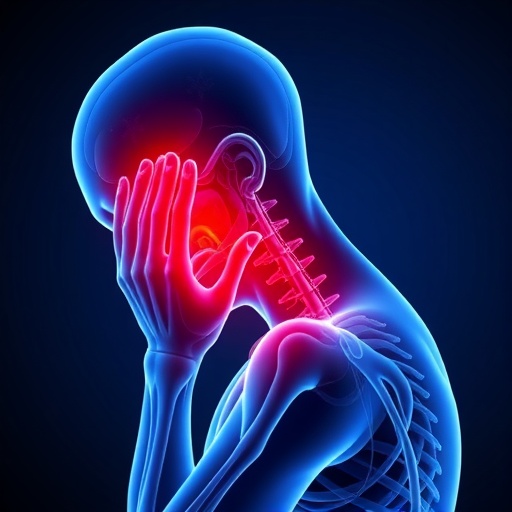In a transformative study shedding light on the intricate relationship between pain and mental health, researchers have delved into the pervasive realm of brachial plexopathy. This degenerative condition, which affects the nerves controlling movement and sensation in the arm and hand, poses a considerable challenge not only due to its physical implications but also due to its psychological aftermath. The study, led by Tito-Huaraqui and colleagues, showcases how physical pain is often intertwined with emotional disturbances, emphasizing the critical need for an integrated approach to treatment.
Brachial plexopathy, a disorder arising from damage to the brachial plexus nerves, can result from various causes, including trauma, tumors, or even systemic diseases. Patients suffering from this condition experience not just debilitating physical symptoms but are often haunted by symptoms of depression. The psychological burden of chronic pain can significantly diminish a person’s quality of life, demanding attention from healthcare professionals and caregivers alike. This correlation between pain and depression is profoundly compelling and warrants deeper exploration.
The methodology employed by the researchers involved a cross-sectional analysis of a diverse patient population diagnosed with brachial plexopathy. By utilizing standardized psychological assessment tools, the team aimed to elucidate the connection between the severity of pain experienced and the prevalence of depressive symptoms. This approach is fundamental in deciphering how chronic physical conditions can precipitate mental health issues, providing crucial insights into the biopsychosocial model of health.
As the research unfolded, the team discovered that higher levels of pain were significantly correlated with increased instances of depression among participants. This finding aligns with a growing body of literature that indicates a cyclical relationship between chronic pain and depression. It is essential to note that while pain can exacerbate depressive symptoms, depression can also heighten a patient’s perception of pain, creating a challenging feedback loop that complicates treatment efforts.
The implications of these findings are vast and multifaceted. For clinicians, the recognition that patients with brachial plexopathy are likely to experience depressive symptoms underscores the importance of comprehensive assessments that encompass both physical and emotional health. Addressing pain management without considering its psychological dimensions may lead to suboptimal outcomes, as many patients require an interdisciplinary approach that includes both pain management and psychological support.
Moreover, the study highlights the necessity for healthcare systems to adopt a more holistic view of patient care. Recognizing the interplay between physical ailments and mental health is crucial in developing treatment protocols that are not only effective but also compassionate. This study serves as a clarion call to re-evaluate treatment paradigms, ensuring that mental health is prioritized when dealing with patients suffering from chronic pain conditions.
In addition, the pursuit for sustainable management strategies for brachial plexopathy must include an array of therapeutic interventions that target both physical pain and emotional turmoil. Cognitive-behavioral therapy, mindfulness techniques, and pharmacological treatments for depression should be considered integral components of a comprehensive treatment plan. This is especially vital in a population that may be reluctant to discuss their emotional struggles, often sidelining mental health in favor of solely addressing physical symptoms.
Furthermore, the study opens avenues for future research focusing on the causal mechanisms linking pain and depression. By investing in longitudinal studies, researchers can better understand how these conditions influence one another over time and subsequently influence the development of more targeted treatments. This understanding will pave the way for innovative therapeutic approaches that are personalized to meet individual patient needs.
As the research community grapples with these complex interactions, it also raises significant questions about how various demographic factors—such as age, gender, and socioeconomic status—may influence the relationship between chronic pain and mental health. Further exploration into how these variables intersect can enrich our understanding of patient experiences and inform better design for interventions.
Recognizing that addressing pain and depression simultaneously can be a formidable challenge, the study encourages healthcare providers to engage in open dialogues with patients regarding their emotional health. By fostering an environment where patients feel safe to disclose their struggles with depression, healthcare professionals can take significant steps towards creating more supportive care systems.
In conclusion, the work presented by Tito-Huaraqui and colleagues paints a vivid picture of the intertwined nature of somatic and psychological pain and challenges us to rethink our treatment strategies for those afflicted by brachial plexopathy. It is essential that as a society, we advocate for integrative approaches recognizing the whole person—their physical sensations and their emotional experiences—as we push towards more effective healthcare solutions.
With the publication of this study in Discover Mental Health, an increasing awareness surrounding the psychosocial dimensions of chronic illness is undoubtedly on the horizon, urging an evolution in how we approach and engage with various medical disciplines in pursuit of holistic health.
Subject of Research: The association between pain and depression in patients with brachial plexopathy.
Article Title: Cross-sectional study of the association between pain and depression in patients with brachial plexopathy.
Article References:
Tito-Huaraqui, E.M., Silveira-Machado, L., Huancahuire-Vega, S. et al. Cross-sectional study of the association between pain and depression in patients with brachial plexopathy.
Discov Ment Health 5, 183 (2025). https://doi.org/10.1007/s44192-025-00322-2
Image Credits: AI Generated
DOI: https://doi.org/10.1007/s44192-025-00322-2
Keywords: Brachial plexopathy, Chronic pain, Depression, Mental health, Interdisciplinary treatment, Biopsychosocial model, Pain management, Psychological assessment.




